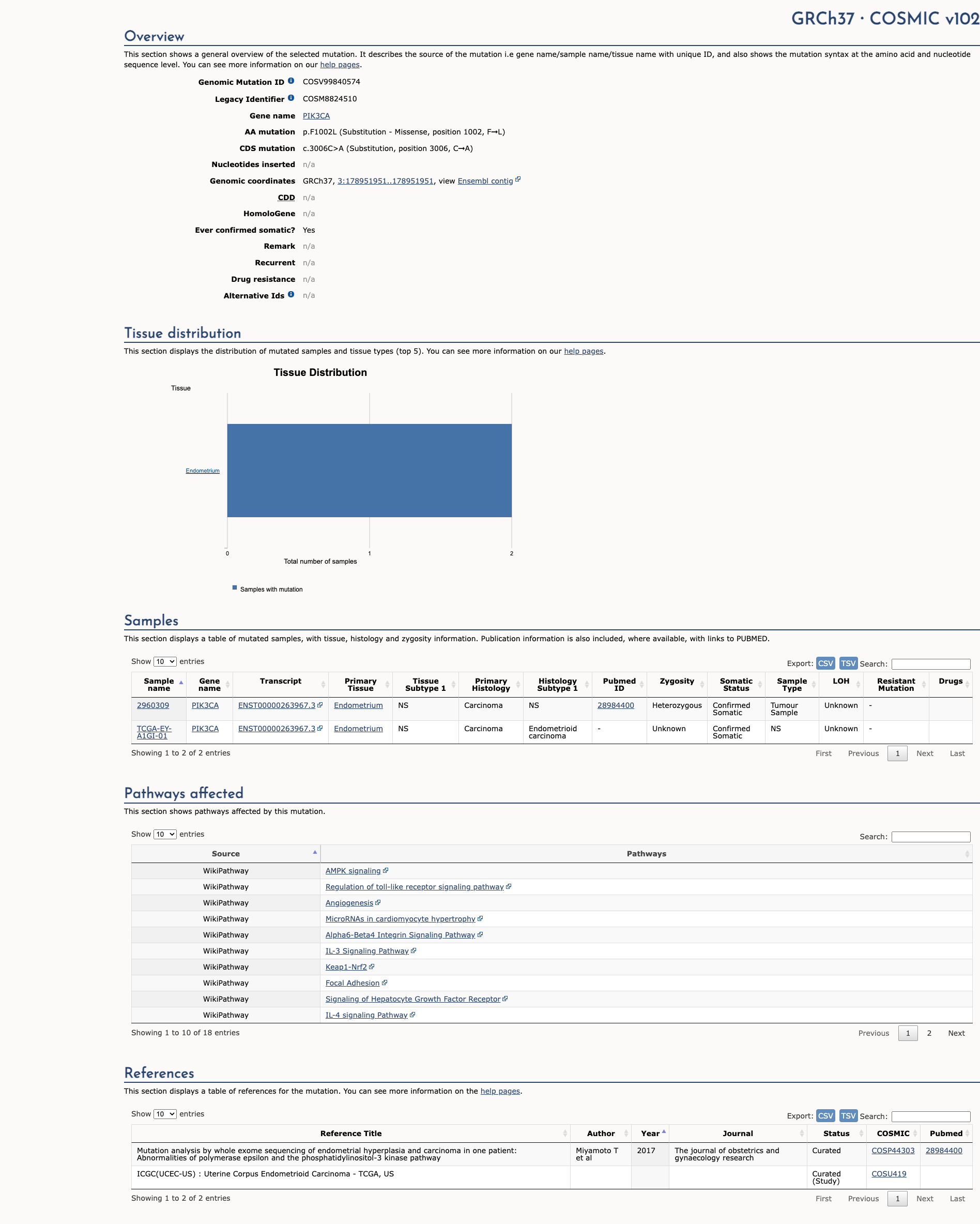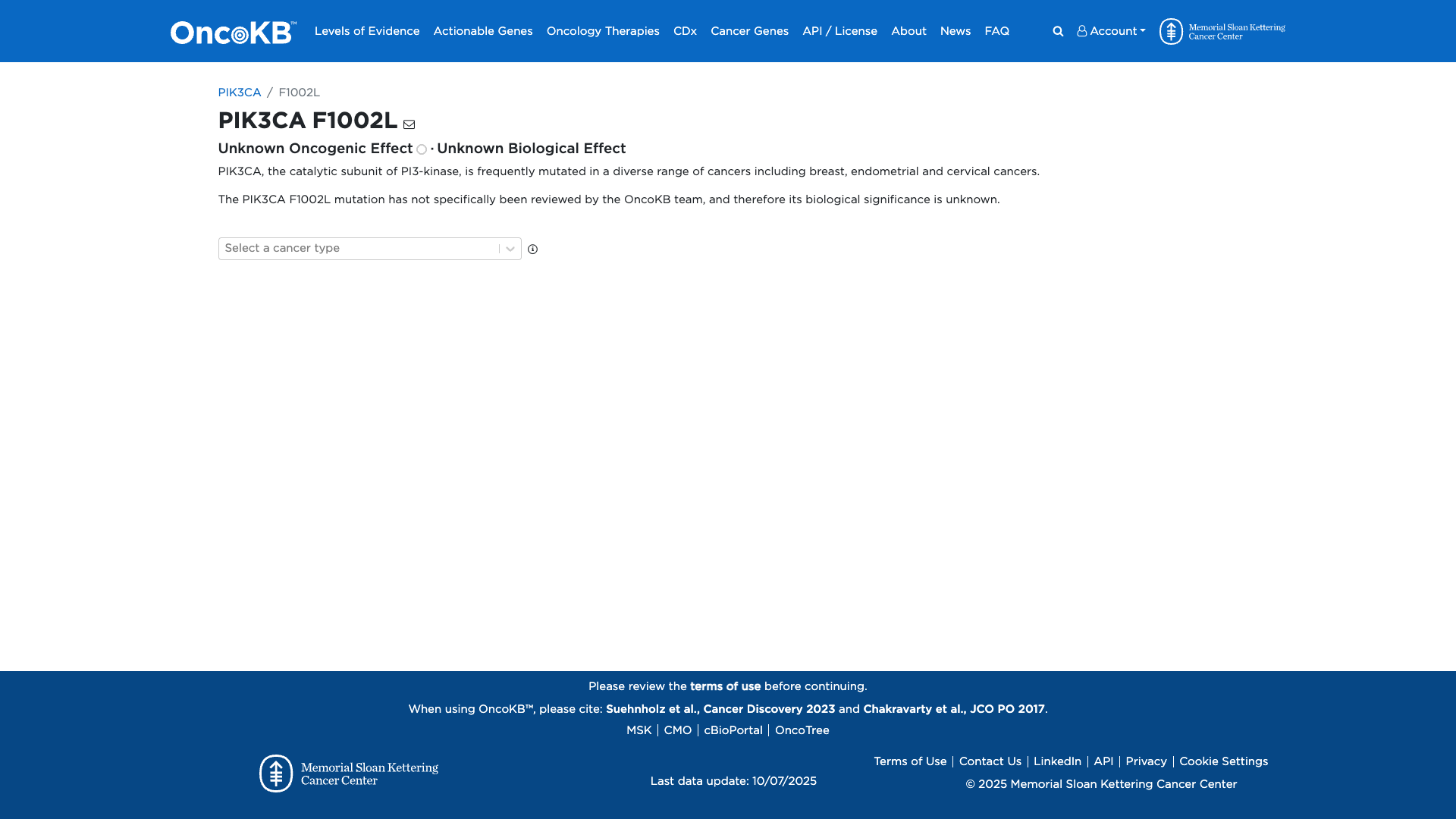PIK3CA c.3006C>A, p.Phe1002Leu
NM_006218.4:c.3006C>A
COSMIC ID: COSM8824511
Variant of Uncertain Significance (VUS)
This novel missense variant (PIK3CA F1002L) is absent from population databases (PM2_Supporting) and occurs in a constrained missense context (PP2_Supporting). All other criteria lack sufficient evidence or are not applicable. With only two Supporting pathogenic criteria, the variant remains classified as VUS.
ACMG/AMP Criteria Applied
PM2
PP2
Genetic Information
Gene & Transcript Details
Gene
PIK3CA
Transcript
NM_006218.4
MANE Select
Total Exons
21
Strand
Forward (+)
Reference Sequence
NC_000003.11
Alternative Transcripts
| ID | Status | Details |
|---|---|---|
| NM_006218.2 | Alternative | 21 exons | Forward |
| NM_006218.3 | Alternative | 21 exons | Forward |
Variant Details
HGVS Notation
NM_006218.4:c.3006C>A
Protein Change
F1002L
Location
Exon 21
(Exon 21 of 21)
5'Exon Structure (21 total)3'
Functional Consequence
Loss of Function
Related Variants
No evidence of other pathogenic variants at position 1002 in gene PIK3CA
Alternate Identifiers
COSM8824511
Variant interpretation based on transcript NM_006218.4
Genome Browser
Loading genome browser...
HGVS InputNM_006218:c.3006C>A
Active Tracks
ConservationRefSeqClinVargnomAD
Navigation tips: Use mouse to drag and zoom. Click on features for details.
Clinical Data
Population Frequency
Global Frequency
0.0 in 100,000
Extremely Rare
Global: 0.0%
0%
0.05%
0.1%
1%
5%
10%+
ACMG Criteria Applied
PM2
This variant is not present in gnomAD (PM2 criteria applies).
Classification
Unknown
Publications (0)
No publication details.
Clinical Statement
Functional Impact
Functional Domain
Hotspot Status
Not a hotspot
Domain Summary
This variant is not located in a mutational hotspot or critical domain (0 mutations).
Related Variants in This Domain
No evidence of other pathogenic variants at position 1002 in gene PIK3CA
Computational Analysis
Pathogenicity Predictions
REVEL Score
0.445
0.445
Likely Benign0.0
Uncertain (Low)0.2
Uncertain (Med)0.5
Likely Pathogenic0.75
REVEL scores ≥ 0.75 are strong evidence (PP3)
Predictor Consensus
Mixed/VUS
PP3 Applied
No
Additional Predictors
Pathogenic:
sift: Dmutationtaster: Dprovean: Dprimateai: Ddeogen2: D
Benign:
CADD: 4.38mutationassessor: Lmetasvm: Tmetalr: T
Neutral: Show all
VCEP Guidelines
Applied ACMG/AMP Criteria (VCEP Specific) VCEP Guidelines
PVS1
PVS1 (Not Applied) Strength Modified
According to standard ACMG guidelines, the rule for PVS1 is: null variant (nonsense, frameshift, canonical ±1 or 2 splice sites, initiation codon, single exon or multiexon deletion) in a gene where loss of function is a known mechanism of disease. The evidence for this variant shows: a missense change (F1002L) not predicted to cause loss of function. Therefore, this criterion is not applied.
PS1
PS1 (Not Applied) Strength Modified
According to standard ACMG guidelines, the rule for PS1 is: same amino acid change as a previously established pathogenic variant regardless of nucleotide change. The evidence for this variant shows: no previously established pathogenic variant resulting in F1002L. Therefore, this criterion is not applied.
PS2
PS2 (Not Applied) Strength Modified
According to VCEP guidelines, PS2 requires de novo occurrence with confirmed maternity/paternity and/or tissue-specific evidence for somatic contexts. The evidence for this variant shows: no data on parental or tissue segregation. Therefore, this criterion is not applied.
PS3
PS3 (Not Applied) Strength Modified
According to VCEP guidelines, PS3 requires well-validated functional assays demonstrating a deleterious effect. The evidence for this variant shows: no functional studies available for F1002L. Therefore, this criterion is not applied.
PS4
PS4 (Not Applied) Strength Modified
According to VCEP guidelines, PS4 requires quantitative case/phenotype data (absent from controls per PM2) with point-based scoring. The evidence for this variant shows: no reported cases or phenotype data. Therefore, this criterion is not applied.
PM1
PM1 (Not Applied) Strength Modified
According to VCEP guidelines, PM1 Supporting is for residues affecting critical functional domains provided in Table 4. The evidence for this variant shows: F1002 is not within a VCEP-defined hotspot or critical domain. Therefore, this criterion is not applied.
PM2
PM2 (Supporting) Strength Modified
According to VCEP guidelines, the rule for PM2 is: Supporting Absent/rare from controls in an ethnically-matched cohort population sample (≥1). The evidence for this variant shows: absent from gnomAD and other population databases (MAF=0%). Therefore, this criterion is applied at Supporting strength because the variant is absent from controls.
PM3
PM3 (Not Applied) Strength Modified
According to standard ACMG guidelines, the rule for PM3 is: detected in trans with a pathogenic variant for a recessive disorder. The evidence for this variant shows: insufficient data on trans observations and PIK3CA is not a recessive gene. Therefore, this criterion is not applied.
PM4
PM4 (Not Applied) Strength Modified
According to standard ACMG guidelines, the rule for PM4 is: protein length changes due to in-frame indels or stop-loss variants. The evidence for this variant shows: a single amino acid substitution without length change. Therefore, this criterion is not applied.
PM5
PM5 (Not Applied) Strength Modified
According to standard ACMG guidelines, the rule for PM5 is: novel missense change at an amino acid residue where a different missense change is pathogenic. The evidence for this variant shows: no other pathogenic missense at F1002. Therefore, this criterion is not applied.
PM6
PM6 (Not Applied) Strength Modified
According to standard ACMG guidelines, the rule for PM6 is: assumed de novo without confirmation of paternity/maternity. The evidence for this variant shows: no de novo data. Therefore, this criterion is not applied.
PP1
PP1 (Not Applied) Strength Modified
According to standard ACMG guidelines, the rule for PP1 is: cosegregation with disease in multiple affected family members. The evidence for this variant shows: no segregation data. Therefore, this criterion is not applied.
PP2
PP2 (Supporting)
According to VCEP guidelines, the rule for PP2 is: Supporting Missense constraint computed in ExAC/gnomAD was utilized; award if z-score > 3.09 for PIK3CA. The evidence for this variant shows: PIK3CA has a missense z-score > 3.09 and the variant is a missense. Therefore, this criterion is applied at Supporting strength because PIK3CA is constrained and the variant is missense.
PP3
PP3 (Not Applied) Strength Modified
According to standard ACMG guidelines, the rule for PP3 is: multiple lines of computational evidence support a deleterious effect. The evidence for this variant shows: conflicting in silico predictions with a REVEL of 0.45 and SpliceAI predicting no impact. Therefore, this criterion is not applied.
PP4
PP4 (Not Applied) Strength Modified
According to standard ACMG guidelines, the rule for PP4 is: patient’s phenotype or family history highly specific for a disease with a single genetic etiology. The evidence for this variant shows: no phenotype data. Therefore, this criterion is not applied.
PP5
PP5 (Not Applied) Strength Modified
According to standard ACMG guidelines, the rule for PP5 is: reputable source classifies variant as pathogenic. The evidence for this variant shows: no entries in ClinVar or other expert databases. Therefore, this criterion is not applied.
BA1
BA1 (Not Applied) Strength Modified
According to VCEP guidelines, the rule for BA1 is: Stand Alone allele frequency > 0.0926%. The evidence for this variant shows: MAF=0% in population databases. Therefore, this criterion is not applied.
BS1
BS1 (Not Applied) Strength Modified
According to VCEP guidelines, the rule for BS1 is: Strong allele frequency > 0.0185%. The evidence for this variant shows: MAF=0%. Therefore, this criterion is not applied.
BS2
BS2 (Not Applied) Strength Modified
According to VCEP guidelines, the rule for BS2 is: Strong observation in ≥3 healthy adult individuals. The evidence for this variant shows: no homozygotes or multiple healthy carriers documented. Therefore, this criterion is not applied.
BS3
BS3 (Not Applied) Strength Modified
According to VCEP guidelines, the rule for BS3 is: Strong well-validated functional studies showing no damaging effect. The evidence for this variant shows: no functional assays. Therefore, this criterion is not applied.
BS4
BS4 (Not Applied) Strength Modified
According to standard ACMG guidelines, the rule for BS4 is: lack of segregation in affected members. The evidence for this variant shows: no segregation data. Therefore, this criterion is not applied.
BP1
BP1 (Not Applied) Strength Modified
According to standard ACMG guidelines, the rule for BP1 is: missense in a gene where only truncating variants cause disease. The evidence for this variant shows: PIK3CA disease is driven by activating missense variants. Therefore, this criterion is not applied.
BP2
BP2 (Not Applied) Strength Modified
According to standard ACMG guidelines, the rule for BP2 is: observed in cis or trans with a pathogenic variant. The evidence for this variant shows: no data on cis/trans occurrence. Therefore, this criterion is not applied.
BP3
BP3 (Not Applied) Strength Modified
According to standard ACMG guidelines, the rule for BP3 is: in-frame indel in a repetitive region without known function. The evidence for this variant shows: it is a missense, not an indel. Therefore, this criterion is not applied.
BP4
BP4 (Not Applied) Strength Modified
According to VCEP guidelines, BP4 applies only to synonymous, intronic, or UTR variants with splicing predictions. The evidence for this variant shows: a missense change with conflicting computational predictions. Therefore, this criterion is not applied.
BP5
BP5 (Not Applied) Strength Modified
According to standard ACMG guidelines, the rule for BP5 is: variant found in a case with an alternate molecular basis for disease. The evidence for this variant shows: no evidence of another molecular diagnosis. Therefore, this criterion is not applied.
BP6
BP6 (Not Applied) Strength Modified
According to standard ACMG guidelines, the rule for BP6 is: reputable source classifies variant as benign. The evidence for this variant shows: no such classifications in ClinVar or other databases. Therefore, this criterion is not applied.
BP7
BP7 (Not Applied) Strength Modified
According to standard ACMG guidelines, the rule for BP7 is: synonymous or intronic variant with no splicing impact and low conservation. The evidence for this variant shows: it is missense. Therefore, this criterion is not applied.



